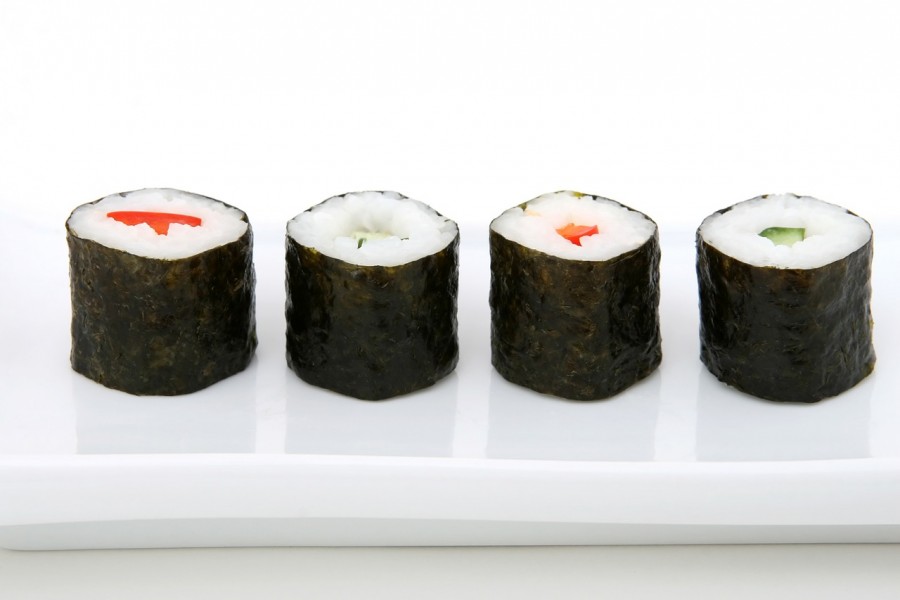Maki sushi (or pronounced maki zushi), literally means rolled sushi. Americans are very accustomed to the wide variety of sushi rolls available here in the United States, but in Japan, maki sushi is quite limited. Therefore, we will be differentiating the Japanese maki sushi with Westernized sushi rolls here.
Contents:
- What is Maki Sushi?
- 10 Most Popular Maki Sushi Menu
- How to cook Maki Sushi?
- Let’s Make Kazari Makizushi!
What is Maki Sushi?
Maki sushi is divided into 3 types, hosomaki (thin roll), futomaki (thick roll) and the temaki (hand roll). In the United States, a new genre was created – the uramaki (reverse roll) which is discussed under westernized sushi rolls. In Japan, with very few exceptions, maki sushi are wrapped in nori (dried seaweed). Uramaki, where the rice is facing the outside is a very new phenomenon that was introduce in the late 70’s. While chefs are free to put anything inside the rolls, most sushi chefs stick to the tradition and do not improvise. Instead, supermarkets and convenience stores have been the ones to make those improvisations by making salad rolls, tempura rolls, and dessert rolls for inside lunch boxes.
Hosomaki (thin roll sushi)
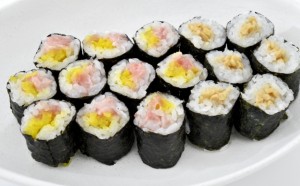
Hosomaki is usually about an inch thick in diameter, with one or two ingredients inside. Unlike the colorful uramaki, hosomaki is simple in design, with black-ish green nori exterior, white sushi rice, and a single color ingredient (similar to a Japanese flag). Some ingredients that are used are maguro (tuna), kappa (cucumber), kanpyo (pickled calabash gourd), natto (fermented soy beans), and other pickles and vegetables. The hosomaki will be served cut, usually into 8 to 10 pieces and is served at the end of an omakase meal.
Futomaki (thick roll sushi)
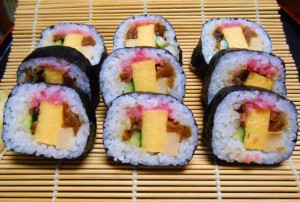
When chefs want to put multiple ingredients (anything above three) in a roll, they will resort to the futomaki method. The futomaki uses a full sheet of nori, instead of half for the hosomaki, and has a diameter of about 2 to 2.5 inches. Normally, it will consist of a Japanese egg omelet, a green vegetable (spinach, cucumber), and a variety of pickles. These are made for takeout purposes, and rarely will you see someone ordering futomaki for dinning at a restaurant. It is used as a souvenir for family members who could not join the dinner (raw sushi will go bad quickly, and may not suited for take outs). While they are served cut, there is a tradition of eating the eho-maki (a special roll made for this tradition) without cutting it. This tradition takes place on the Setsubun festival in February where people will all eat the eho-maki without speaking a single word while facing a specific direction (the direction changes each year). This is supposed to bring good fortune, and it is bad luck to speak while eating the eho-maki.
Temaki (hand roll sushi)
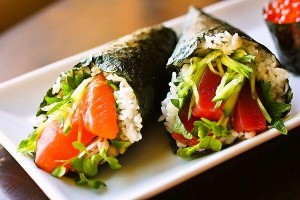 Available in the sushi restaurants here in the United States as “hand roll”, temaki is in-between a hosomaki and futomaki, allowing chefs to increase the variety of ingredients, and still not having to serve a large volume. Temaki is made for each person, as it is not cut. Some people prefer the temaki over the hosomaki, even if the ingredients are exactly the same, because the nori is kept fresher due to its crispiness (hosomaki is pressed down on the sumaki, so it will not be crispy). Because hosomaki and temaki take time to prepare, families in Japan will have temaki sushi parties where everyone can make his or her own hand roll at the dinner table. Common ingredients include salmon, tuna, salmon roe, egg omelet, and other vegetables and pickles.
Available in the sushi restaurants here in the United States as “hand roll”, temaki is in-between a hosomaki and futomaki, allowing chefs to increase the variety of ingredients, and still not having to serve a large volume. Temaki is made for each person, as it is not cut. Some people prefer the temaki over the hosomaki, even if the ingredients are exactly the same, because the nori is kept fresher due to its crispiness (hosomaki is pressed down on the sumaki, so it will not be crispy). Because hosomaki and temaki take time to prepare, families in Japan will have temaki sushi parties where everyone can make his or her own hand roll at the dinner table. Common ingredients include salmon, tuna, salmon roe, egg omelet, and other vegetables and pickles.
10 Most Popular Maki Sushi Menu
Although many of the following maki sushi are not famous here in the United States (Western sushi rolls are far more common), we gave it a shot, and asked our audiences if they knew any of these maki sushi, and which ones were their favorite. So here it goes, from 10th to 1st, the most popular maki sushi in the United States.
10. Gobo Maki
Gobo is burdock root that is consumed in Japan. While most Japanese dishes that use burdock root involve either simmering or pan-frying it, in sushi, burdock root is pickled. You might have seen a blood-orange colored stick in your hand rolls or cut rolls. Many mistake it as carrots, but they are actually pickled burdock roots, and are a key ingredient in many rolls.
9. Umeshiso Maki
Umeshiso maki is a roll consisting of umeboshi (sour pickled plum) and shiso leaves. Interestingly enough, red shiso leaves are used in the process of pickling umeboshi, so as you can imagine, shiso and umeboshi really go well together. But because the sourness of umeboshi is very strong, chefs add shiso leaves to ease this up a bit, in this delightful maki sushi.
8. Umekyu Maki
Umekyu maki is very similar to the umeshiso maki. Using the umeboshi plums, it is wrapped into a roll with, instead of shiso leaves, cucumber (kyuri). For those that like the kappa (cucumber) maki, it adds a nice sour taste to it. For those that like umeshiso maki, it adds a nice crispy cucumber texture to your roll.
7. Shinko Maki
O-shinko is a Japanese word for pickles, and as you can imagine, the shinko maki is made with pickles. Normally, you will see a chef use the takuan pickle (yellow colored pickled radish). Like the kanpyo pickles, takuan is sweet in flavor and the combination of the vinegar rice, sweet takuan, and soy sauce create a sweet, sour, salty flavor. In many Japanese stores, the use of food coloring is being discouraged, and the yellow takuan pickles are becoming rare. Many of these sushi restaurants will instead use the brown (uncolored) takuan pickles.
6. Kanpyo Maki
Kanpyo is made of strips of dried calabash gourd and when dried, are impossible to chew through. But in the process of making pickled kanpyo, it is cooked for a long time to give it a sweet taste. Kanpyo maki is also called “teppo maki” in Japanese sushi restaurants. Teppo means a rifle or gun, and the black nori roll with brown center resembles the barrel of a gun. Kanpyo is rich in fiber.
5. Natto Maki
Natto is one of those Japanese foods that Westerners don’t particularly enjoy due to the slimy texture and the smell. Natto is fermented soy beans, and has a brown color. During the process of fermentation, the beans develop a distinct smell and slime. It is so slimy that some natto can produce a single strand of web about 30 feet long! That sure makes it appetizing, right? Natto is loved by Japanese restaurants, and if you want to impress your sushi chef, it is something definitely worth a shot.
“Natto has an acquired taste but I love it. It’s also healthy for our body.” (Rina, Female 20’s)
“Love natto. After having a lot of flavor explosions it’s a good choice to go back to basics and taste on of the most unique Japanese flavors.” (Mai, Female 30’s)
4. Kappa Maki
Kappa is a Japanese fairy tale creature that lives in lakes and rivers in the countryside. Because it was said to be green and loved to eat cucumbers, the name of this cucumber maki sushi was named after it. Kappa maki and tamago nigiri are usually the first sushi a child in Japan will eat. But adults still love kappa Maki for its simple and light taste, a nice change in flavor from all the fish they eat.
“Tasty and delicious, I like the style, easy to eat, and fresh healthy food in the world.” (Jenny, Female 30’s)
3. Negitoro Maki
Negitoro is a combination of minced toro (fatty tuna) and scallions. Chefs will always have small bits and pieces of fish left over, and while some can be thrown away, things like toro are a little too expensive. Therefore, chefs will use that leftover toro for these rolls. That is why negitoro rolls are not too expensive, despite using expensive toro. However, some expensive restaurants won’t even use these leftovers, they’ll just slice off a piece of their finest toro just for their negitoro rolls, if this is the case expect a higher price for your maki sushi.
“The green onion goes well with the tuna. These are small rolls which can be shared easily with your dining guests. I feel it’s almost a small appetizer.” (Boudewijn, Male 30’s)
“Green onion gives it good flavor in addition to the fish and rice and seaweed. Green onion makes a really big difference.” (Melo, Female 30’s)
“Delicious. The toro tastes great with the green onion and tastes best in a hand roll” (Miki, Female 30’s)
“Again, Toro is delicious. Of medium-overlooked green onion combination is exceptional.” (Yoshinori, Male 50’s)
2. Anakyu Maki
Anakyu is very similar to the western favorite, the eel and cucumber roll. Instead of unagi (fresh water eel), anakyu uses anago (saltwater eel), and is wrapped hosomaki style. Japanese people prefer the slightly leaner anago over the fatty unagi, and that is why for hosomaki, there is anakyu.
“The combination of sea eel and cucumber is very refreshing and delicious! Cucumbers always make things taste fresh!” (Javi, Male 30’s)
“Combination of the taste and texture, taste and aroma.” (Javier, Male 50’s)
“I love the tenderness of eel, and even though I don’t eat unagi for conservation reasons, I can eat anago.” (Minxi, Female 20’s)
1. Tekka Maki
Tekka maki is simply put, tuna hosomaki. Tekka (鉄火) means red hot iron in Japanese, and many people believe that’s where the name tekka maki is derived from (from the color of the tuna). However, the name tekka comes from where it was popularly served, the tekkaba, which is a Japanese gambling house. There, people wanted something to conveniently eat with their fingers, and tuna hosomaki became an ideal snack. Similar to a sandwich which was developed for meals during card games, tekka maki was an ideal maki sushi for gambling houses. Since then, tekka has been associated with tuna, and many restaurants will serve tekka-don, which is a rice bowl with chopped tuna sashimi on top.
“My all-time favorite maki sushi would be tekka maki. I’ve been eating tekka maki for a long time now, and for good reason: it’s simplicity but flavorful from the combination of vinegar rice, slice of tuna, and soy sauce (plus wasabi!) makes me want to eat at least 5 or 10 every time I order a plate.” (Tomomi, Female 50’s)
“I like the taste. The tuna is mild and it reminds me of the first time eating sushi as a young boy. The sushi is simple and small enough to eat in one bite.” (Rodney, Male 40’s)
“Tekka maki has a nice texture and is delicious with a small helping of wasabi and a brushing of soy sauce.” (Cora, Female, 20’s)
” Mild taste, enhances very well with shoyu, texture is just right.” (James, Male 30’s)
Q. Which is your most favorite Maki Sushi?

How to cook Maki Sushi?
Maki Sushi Recipe
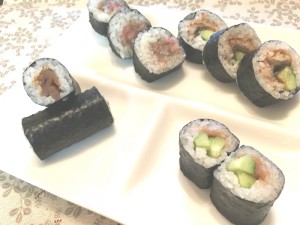
Ingredients (Serves 4)
- 4 cups sushi rice (Sushi Rice Recipe)
- 4 sheets unseasoned nori for sushi
- 4 oz. toro tuna sashimi, minced
- 1 Japanese cucumber
- 3 umeboshi
- 1/2 package (5 oz.) precooked broiled Unagi
- 1 green onion, minced
- 2 Tbsp. sesame seeds
- 1 oz. kanpyo
- 1 cup dashi stock
- 2 Tbsp. soy sauce
- 1 Tbsp. suger
Cooking Directions
How to prepare kanpyo:
- Soak in water 10 to 15 min. Wash and rub with ½ tablespoon of salt until supple. Rinse and boil in water for about 10 min until tender and drain.
- In a saucepan, heat dashi stock, sugar and soy sauce to a boil. Add kanpyo and simmer for 15 min, until the sauce is absorbed. Cut in 10 to 11 inch length.
How to prepare umeboshi, cucumber and unagi:
- Take umeboshi and remove the pits. Tear the umeboshi in half.
- Follow the warming or cooking instruction on the unagi package. Once warmed, let it stand for about 15 min to cool.
- Slice cucumber and unagi into strips.
How to prepare negitoro :
- Mix minced toro sashimi with minced green onion.
Directions to make rolls:
- Cut nori into half sheet size. Select a sheet and place it shiny side down on the bamboo rolling mat. Wet your hands thoroughly with clean water and take about 1/3 a cup of rice and spread it on the lower third of the seaweed sheet. Press it slightly down so that it stays on the sheet.
- Lay the prepared sushi roll ingredients side by side so that they form a horizontal line from one side of the rice on the other, gently pressing them.
- Next grab the bottom of the rolling pad with your fingers, hold the seaweed and rice down against the mat while you lift the mat up. Roll the sushi tightly with the mat to form a neatly packed cylinder.
- Cut each sushi roll and serve with soy sauce.
Let’s Make Kazari Makizushi!
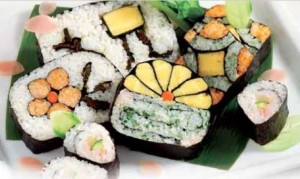 Sushi is representative of Japanese culture. As you probably know, it’s a unique traditional Japanese food that is recognized around the world. Makizushi (rolled sushi), as one of the most time-honored forms of sushi, is customarily made with wishes for agricultural fertility, health and longevity, and appreciation for the deities. There are many versions of makizushi enjoyed by those outside Japan: the California roll (the favorite in the U.S.), the caterpillar roll, the rainbow roll and the Philadelphia roll. The caterpillar roll is especially entertaining to look at: it’s a makizushi that demonstrates a sense of fun.
Sushi is representative of Japanese culture. As you probably know, it’s a unique traditional Japanese food that is recognized around the world. Makizushi (rolled sushi), as one of the most time-honored forms of sushi, is customarily made with wishes for agricultural fertility, health and longevity, and appreciation for the deities. There are many versions of makizushi enjoyed by those outside Japan: the California roll (the favorite in the U.S.), the caterpillar roll, the rainbow roll and the Philadelphia roll. The caterpillar roll is especially entertaining to look at: it’s a makizushi that demonstrates a sense of fun.
Did you know that fun makizushi can also be found in Japan? These are called kazari (decorative) makizushi. At first glance they seem difficult to make, but kazari makizushi are simply the sum of different part such as a mound of sushi rice (shari) or nori (dried seaweed), nori placed inside the rice, or swirls, all joined and rolled together within the makizushi. Once you get used to handling sushi rice, it’s fairly easy to make kazari makizushi.
With a little creativity, you can make a variety of patterns of kazari makizushi. Let’s start with Nonoji Maki, a basic from the even a beginner can make!
Nonoji Maki Recipe
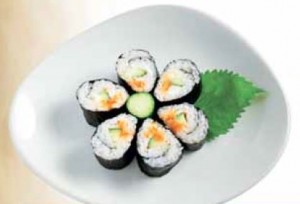
Ingredients (Serves 1 roll)
- 1 sheet sushi nori (dried seaweed)
- 2.8 oz sushi rice*
- 2 to 3 shrimp (boiled and deveined)
- 1 4-inch-long cucumber
- Tobiko (flying-fish roe) (as needed)
- Mayonnaise (as needed)
* Because the size of the nori varied depending on the maker, prepare some extra sushi rice.
Cooking Directions
 Cut off the shrimp tails with a knife. (Cutting off the tails will refine the final look.)
Cut off the shrimp tails with a knife. (Cutting off the tails will refine the final look.) Cut the cucumber in half vertically, then cut each piece into thirds and remove the seeds.
Cut the cucumber in half vertically, then cut each piece into thirds and remove the seeds. Place the nori on the rolling mat (makisu). Position the knots of the rolling mat string toward the back. Place the nori rough-side up (the smooth side should face the bottom.
Place the nori on the rolling mat (makisu). Position the knots of the rolling mat string toward the back. Place the nori rough-side up (the smooth side should face the bottom. Scoop up some water with the second joint of your middle finger, and spread it thinly over your hand. (Use caution, because too much water can dilute the taste of the sushi rice.)
Scoop up some water with the second joint of your middle finger, and spread it thinly over your hand. (Use caution, because too much water can dilute the taste of the sushi rice.) Using the palm of your hand, lightly press the sushi rice into a barrel shape.
Using the palm of your hand, lightly press the sushi rice into a barrel shape. Divide the sushi rice into three equal portions and spread it evenly on the mat. (This will prevent it from becoming smashed.)
Divide the sushi rice into three equal portions and spread it evenly on the mat. (This will prevent it from becoming smashed.) Place your hands on the ends as shown in the photo, and be sure the rice is packed in tightly so that the final product looks clean.
Place your hands on the ends as shown in the photo, and be sure the rice is packed in tightly so that the final product looks clean. Place the cucumber, shrimp and tobiko in the order shown in the photo, and spread the mayonnaise over the tobiko to prevent it from falling apart.
Place the cucumber, shrimp and tobiko in the order shown in the photo, and spread the mayonnaise over the tobiko to prevent it from falling apart. While holding down the ingredients, wrap until you’ve reached the end of the ingredients.
While holding down the ingredients, wrap until you’ve reached the end of the ingredients. Wrap once again to the end of the nori (Now wrap in circular shape to the end of the nori).
Wrap once again to the end of the nori (Now wrap in circular shape to the end of the nori). Reshape the circular roll into a teardrop shape (if rice spills out the sides, push it back in).
Reshape the circular roll into a teardrop shape (if rice spills out the sides, push it back in).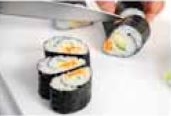 Finally, cut the roll into appropriate-size pieces and display them in a circle.
Finally, cut the roll into appropriate-size pieces and display them in a circle.
Now that you’ve mastered the basic roll, let’s try the Panda next, which is a bit more advanced. The panda’s expression will vary slightly, depending on how it’s rolled. Children love it!
Panda Maki Recipe
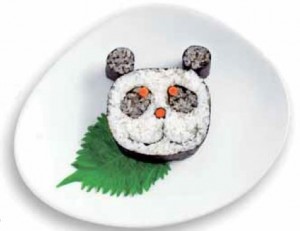
Ingredients (Serves 1 roll)
- Five 1-4 sheets sushi nori, one 1-2 sheet and one 1-6 sheet
- 12 oz. sushi rice*
- 2 or 3 mountain burdock roots
- 1 tsp. ground black sesame seeds
- 1 tsp. yukari (red perilla seasoning)
* Because the size of the nori varied depending on the maker, prepare some extra sushi rice.
Cooking Directions
 Mix the ground sesame seeds and yukari into the sushi rice.
Mix the ground sesame seeds and yukari into the sushi rice. Prepare the five 1/4 sheets of nori.
Prepare the five 1/4 sheets of nori.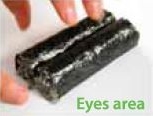 Place 1 oz, of the sushi rice on two of the nori sheets from Step 2, and make two rolls as in Photo2. (This will be “nori roll 1.”)
Place 1 oz, of the sushi rice on two of the nori sheets from Step 2, and make two rolls as in Photo2. (This will be “nori roll 1.”) Place 1.5 oz. of the sushi rice from Photo 2 on top and make a circular roll, as in Photo 4.
Place 1.5 oz. of the sushi rice from Photo 2 on top and make a circular roll, as in Photo 4.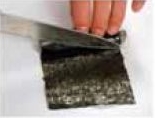 Cut the left-over nori as shown in the photo. (This will be “nori roll 2.”)
Cut the left-over nori as shown in the photo. (This will be “nori roll 2.”)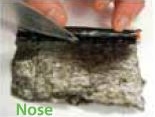 Using a 1/4 sheet of nori from Step 2, cut a burdock root to the same length, and wrap it as the nori roll core. Cut any extras away with a knife.
Using a 1/4 sheet of nori from Step 2, cut a burdock root to the same length, and wrap it as the nori roll core. Cut any extras away with a knife.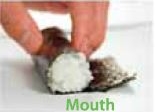 Wrap 1 oz. of sushi rice in a circular shape, as shown in the photo. (This will be “nori roll 3”.)
Wrap 1 oz. of sushi rice in a circular shape, as shown in the photo. (This will be “nori roll 3”.)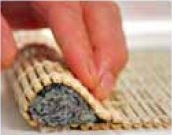 Reshape “nori roll 1” into a teardrop shape.
Reshape “nori roll 1” into a teardrop shape. Cut “nori roll 3” in half.
Cut “nori roll 3” in half.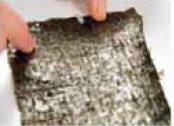 Prepare the 1/2 and 1/6 sheets of nori and connect them using sushi rice, as shown in the photo.
Prepare the 1/2 and 1/6 sheets of nori and connect them using sushi rice, as shown in the photo. Spread 3.5 oz. of sushi rice atop the connected nori, leaving 1.5 inches of space at both ends.
Spread 3.5 oz. of sushi rice atop the connected nori, leaving 1.5 inches of space at both ends. Place 1.5 oz. of sushi rice in the center of the sushi rice, as shown in the photo.
Place 1.5 oz. of sushi rice in the center of the sushi rice, as shown in the photo. Place the teardrop-shaped “nori roll 1” and the burdock root on top.
Place the teardrop-shaped “nori roll 1” and the burdock root on top. Place 0.5 oz. of sushi rice on either side of the burdock root.
Place 0.5 oz. of sushi rice on either side of the burdock root.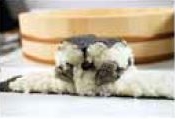 Place “nori roll 3,” which was cut in half earlier, on top as shown in the photo, forming the panda’s nose.
Place “nori roll 3,” which was cut in half earlier, on top as shown in the photo, forming the panda’s nose.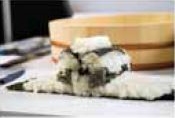 Place 0.75 oz. of sushi rice on the panda’s muzzle section.
Place 0.75 oz. of sushi rice on the panda’s muzzle section.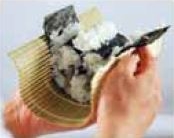 Lift the nori at both ends as you form the roll.
Lift the nori at both ends as you form the roll.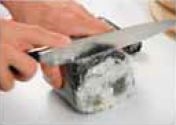 Cut the panda’s face section to 0.6 inch thick. (It is less prone to coming apart if wrapped in plastic wrap.)
Cut the panda’s face section to 0.6 inch thick. (It is less prone to coming apart if wrapped in plastic wrap.)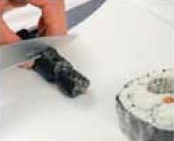 Cut “nori roll 2” 0.6 inch thick the thickness should be same as that of the panda’s face and adjust/set it to the ear positions.
Cut “nori roll 2” 0.6 inch thick the thickness should be same as that of the panda’s face and adjust/set it to the ear positions.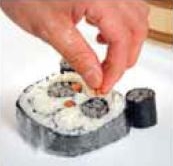 Thinly slice the burdock roots, place them on the panda’s eye section, and you’re done.
Thinly slice the burdock roots, place them on the panda’s eye section, and you’re done.
Kazari Makizushi recipes by Hitoshi Sugiura
 After gaining experience in many restaurants in Kansai and Tokyo, Sugiura flew to America. While training at a New York restaurant, he worked on the development of a co-product. In 2013, after having returned to Japan, he was offered the opportunity to present a meal for a Tiffany’s VIP party, the Blue Book Collection, held at Rockefeller Center. In 2014, he won first place in a cooking competition sponsored by Le Cordon Blue Japan.
After gaining experience in many restaurants in Kansai and Tokyo, Sugiura flew to America. While training at a New York restaurant, he worked on the development of a co-product. In 2013, after having returned to Japan, he was offered the opportunity to present a meal for a Tiffany’s VIP party, the Blue Book Collection, held at Rockefeller Center. In 2014, he won first place in a cooking competition sponsored by Le Cordon Blue Japan.
